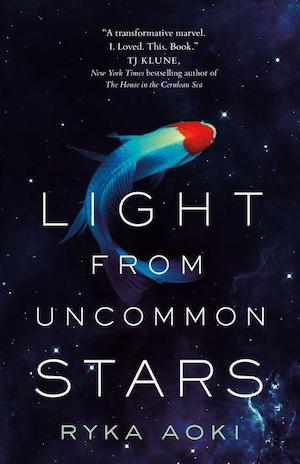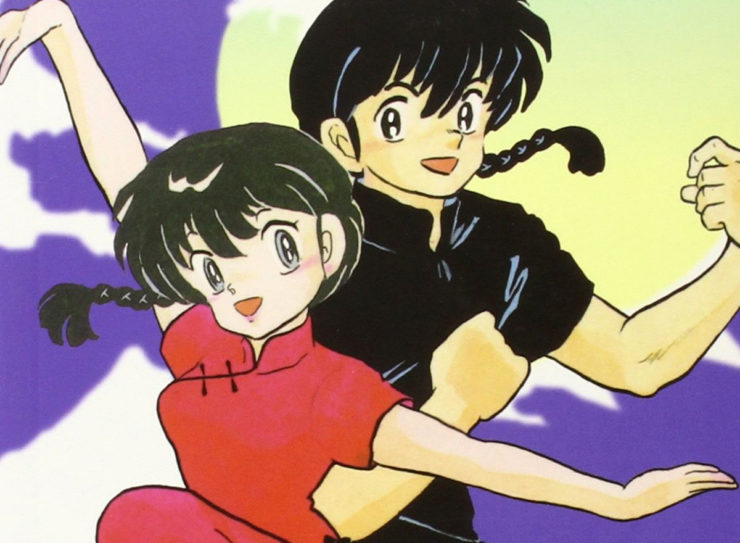The legendary mangaka Rumiko Takahashi’s birthday is October 10, and as it approaches, I thought it might be a great time to chat about my favorite Takahashi manga: Ranma 1/2.
For me, Ranma 1/2 was more than a coming-of-age experience—it was an epiphany. This work not only challenged so many prevailing (and rather depressing) thoughts and philosophies about being trans—but did so as a manga.
In a nutshell, Ranma Saotome is this martial arts dude who is training with his father in China. There, while sparring upon some of those bamboo stakes that fictional martial artists are so fond of sparring upon, Ranma’s father falls into the “Spring of the Drowned Panda” and takes the form of a giant panda. Startled by this, Ranma slips and falls into the “Spring of the Drowned Girl” and the same thing happens—except instead of giant panda, Chinese girl.
And that’s it. Takahashi is not asking us to think too hard about this. It’s China, and there are these cursed “Springs of the Drowned Something-or-another” and you fall in and there you are. Oh, and somehow the curse reverses when splashed with hot water and reasserts itself with cold water…
As I said, not much to think about.
I know that some people question if Ranma Saotome is really transgender—Ranma is transformed by accident, not by intent. Point taken. But to be honest, I didn’t wake up one day and say, “Hello world, I intend to be transgender!” either.
Being transgender was never about being transgender. I was simply trying to understand myself, improve myself—be myself, and SPLASH! Suddenly I was shocked and wide awake and… oh great… now what do I do? I’m not sure if I would call it an accident, but like Ranma’s spring, transness really did feel like something that I fell into.
And now? Well… my life was going to be waaaay more complicated than I had imagined.
Sadly, unlike Ranma, I didn’t have Rumiko Takahashi to write the rest of my life. Instead, I began to read TG/TS/TV (transgender/transsexual/transvestite) articles and visit TG/TS/TV websites, well as the TG/TS/TV listservs on what was passing for the Internet at the time.
These were not my happiest moments. Much of what I found frightened me, both physically and emotionally. Someone stressed how transsexuals should always dress in drab colors to avoid being noticed. Another group met on weekends and modeled themselves after Alcoholics Anonymous. And then there were the depictions of surgeries with lots of blood—not only vaginoplasties focusing on one’s genitals, but of circular saws and shaved down facial bone.
Affirmation surgeries do make so many people’s lives better—and to be clear, the procedures themselves were not the issue at all. What was so scary was the lack of options, the lack of choice. That this was the way to be trans. You would fill this questionnaire and go to this therapist, then see that endocrinologist and that surgeon… here’s your road map. Keep a low profile and don’t talk to strangers until you become the new you.
But remember… if they ever find out that you’re trans… So shhhhh…
What I found so refreshing about Ranma was that the process of transition—the part that seemed to dominate so much trans literature—was not a big deal.
Rather, it was, “Okay, I’m a girl, now what?”
With Ranma 1/2, transition was no great mystery. Takahashi positioned going from male to female as just another off-the-wall thing that happens as you are trying to live your life.
To put this in perspective, although Super Saiyans were introduced in 1991, no female Super Saiyans were shown in the canonical Dragon Ball multiverse until Caulifla in 2017. Apparently, Akira Toriyama couldn’t figure out what a female super Saiyan would look like. For 26 years.
Think about all the weird shit that goes on in Dragon Ball, and Toriyama was balking at a female Super Saiyan?
But with Takahashi? Gender happens. Life goes on. When so much trans centered literature focused upon what is transformed, Takahashi focused on what was preserved. Whether it’s girl Ranma or boy Ranma—Ranma is Ranma.
And I could still be me. There would be no River of Gender to cross and leave my old life behind. Those literary journal rejection letters? They were on my kitchen table today, and they would be there tomorrow. My life had changed course, but it was still my life.
Takahashi focused on slice-of-life, not slice-of-genitals. If Hedwig and the Angry Inch (which one can argue isn’t a trans story, either) had been like Ranma 1/2, there’d be no surgeon, no blood—the movie would have been about a loveable, arrogant musician, maybe with a lazy furry for a father, and assorted misadventures centering on confused groupies and whether the band would have a front man or front woman for the concert that night.
And, best of all, since Takahashi rarely portrayed Ranma as a victim—and never as someone to be pitied—we were free to laugh. When Akane meets Ranma in the bathhouse, first as a girl, then as a boy, then becoming confused later because even though Ranma was now a girl, Ranma had also been a boy…
Yeah… been there, done that. Still cringe.
And beyond the humor, sometimes Takahashi would get something just stunningly right.
For example, I’m a martial artist. Not as nearly as invincible as Ranma Saotome—but after over four decades of training, competition, and teaching, I think I’m pretty good. Being trans has nothing to do with my love of martial arts. All of my techniques are there. In fact, I’m probably better now with some of them. However, after taking hormones for years, I lost much of my physical power. Yes, I still train. I’m still stronger than many people. But I don’t have my old power. Not even close.
So, when I saw boy Ranma fight the monstrously strong Ryoga, then turn into girl Ranma—I loved how she didn’t become weak or scared. Yes, she seemed befuddled as to why her techniques weren’t having the same effect… but rather than quitting, Ranma started working with her body and its capabilities.
I felt so seen.
Buy the Book


Light From Uncommon Stars
There are many, many ways to express transgender, to define transgender, to be transgender. It’s never been a single-lane road. Yes, the information on those listservs was important—some of the best and most well-intentioned that we had at the time—and the writers and activists who posted there saved many, many lives.
But to someone from an Asian family who had been beaten and was trying not to draw attention to herself, so much of that information was terrifying, limiting—even invalidating.
By writing Ranma 1/2, Rumiko Takahashi gave me an alternate narrative, an outlying data point. There was this character who was a boy and then a girl and even though it got silly in places (there was a panda and later a piglet), Ranma’s story provided me the space and permission to consider—perhaps for the first time in my life—how much of gender is cultural, personal, and variable. Maybe even fluid.
Becoming Ryka hasn’t always been easy—I have no regrets, but I’ve lost close friendships and too many close friends. I’ve even lost pieces of myself—for a while, the hormones made it nearly impossible for me to write.
However, through those times, in so many ways, Ranma 1/2 helped me to believe that I could walk this path and still be me.
And Ranma’s story inspires me to this day.
So, with that, I would like to wish a very happy birthday to Rumiko Takahashi—may there be many, many more to come!
Thank you so much for creating Ranma 1/2.
<3
Ryka
Ryka Aoki (she/her) is a poet, composer, teacher, and novelist whose books include He Mele a Hilo and two Lambda Award finalists, Seasonal Velocities and Why Dust Shall Never Settle Upon This Soul. Ryka’s work has appeared or been recognized in publications including Vogue, Elle, Bustle, Autostraddle, PopSugar, and Buzzfeed. Her poetry was featured at the Smithsonian Asian Pacific American Center, and she was honored by the California State Senate for “extraordinary commitment to the visibility and well-being of Transgender people.”










